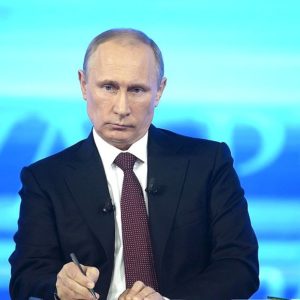Over the past few months, at least 100,000 Russian troops have assembled next to that country’s western border with Ukraine – a chilling and unprecedented scene not witnessed since Moscow annexed Crimea in 2014. Some international observers have pointed to it as Putin’s posturing and a means to chest thump at the new Biden administration. Others have expressed deeper concerns that it is the start of another plan to seize Ukrainian territory.
But what remains indisputable to many analysts is Washington must not look weak in this ongoing watershed moment, which could ultimately set the stage for how far the Kremlin is willing to go to advance its interests both around and outside of its neighborhood.
Indeed, the hostilities caught Biden’s eye.
In the early days of the re-flaring of tensions, the U.S. president condemned Moscow’s aggression, called his Russian counterpart, and dangled the offer of a potential summit meeting. Biden then put forth – via executive order – a new slate of economic sanctions against 38 Russian entities alleged to have been involved in cyberattacks and election meddling, as well as on those connected to the occupation of Crimea. The Biden administration also barred U.S. banking institutions from doing business with newly-issued Russian state debt and bonds and expelled 10 diplomats from U.S. soil.
Yet Biden’s policy is rooted in timid de-escalation, going for mild prohibitions and additional sanctions – none of which directly impact Putin, the top echelons of his circle, or their families. And Biden is allowing the Nord Stream 2 pipeline to move forward.
Biden’s actions mark a major pullback compared to his earlier characterization of the Russian leader as “a killer.”
The rising tensions with an emboldened Moscow marks an early yet defining test of the new president’s leadership and willingness to go as far as necessary to contain a burbling nemesis and shore up Washington’s position as a global leader.
“Putin will stop at nothing to ensure Ukraine is always a buffer state between NATO and Russia. Biden’s policy at first was no policy as the administration was caught off guard trying to tackle the pandemic, political crisis economic recovery and international challenges like China and Iran,” explained Harry Kazianis, senior director at the Center for the National Interest. “Nonetheless, Putin’s troop buildup is meant as a signal to Biden that he cannot be ignored and to not interfere in his plans to dominate not only Ukraine but all of the former states of the USSR. Now Biden must try to cobble some sort of policy of out nothing, which won’t be easy.”
Moscow’s actions continue to ignite panic not only in Kyiv – a NATO ally but not yet a partner – but in allies around the globe. The E.U.’s foreign policy chief Josef Borrell warned this week that it would take a mere “spark” to trigger full-scale hostilities in eastern Ukraine’s Donetsk and Luhansk regions, where tensions have been simmering between government soldiers and pro-Russian separatists for some six years and claimed more than 14,000 lives.
A peace agreement in 2015 ended the significant bouts of fighting in those pockets of eastern Ukraine. Yet, the peace process has stalled since leaving separatist areas essentially self-declared republics, with Moscow publicly denying involvement. But, according to multiple analysts, Putin and company are still pulling strings as the shadow government.
Like Biden, U.S. Secretary of State Antony Blinken has offered a public condemnation of the Russian troop amassing, all while standing next to NATO Secretary-General Jens Stoltenberg. However, the U.S. and its allies are yet to unveil a clear-cut position on Ukraine’s assimilation with the West, despite the country forgoing its nuclear stockpile. Beyond the public rhetoric, neither the U.S. nor the E.U. has projected much in the way of definitive action against Russian transgressions.
However, Benjamin Friedman, policy director at Defense Priorities, contended Biden’s policy – while “pragmatic” might be “too strong.”
“Biden offered to start a new strategic dialogue with Russia to deal with these matters, among others. He has indicated attacking Ukraine would have economic and diplomatic consequences for Russia but promised Ukraine nothing concrete, which is good. Claiming to defend it with military support or offering it a path to NATO membership might trigger a Russian attack to lock in gains before those defenses manifest,” he explained. “And offering to help Ukraine more might also cause it to avoid the sort of settlement with Russia its unfortunate circumstances demand.”
As it stands, Russian defense minister Sergei Shoigu has referred to the maneuver of three airborne units, two armies, and the establishment of a new highly discernable field base as merely a “readiness check” to counter an uptick of activity by the U.S. and NATO partners. The Kremlin has vowed to keep its troops there for as long as it deems necessary.
Moreover, Moscow remains vehemently against any NATO expansions and highly dubious of Western moves in and around its terrain. And if the lessons of 2014 and Crimea serve as any ballpark, Russia is not concerned with taking matters into its own hands.
“For his part, Biden is no longer vice president and having to play second fiddle to anyone. He wants to prove he is a statesman and a world leader, and who better to show his metal to than that ‘killer’ and ‘KGB thug’ Putin,” added John Wood, analyst and author of “Russia, the Asymmetric Threat to the United States.”
“Accordingly, the U.S. can and should draw a red line in the sand with respect to Ukraine. But the wounded Russian bear is more dangerous and volatile than a strong Russian bear.”

